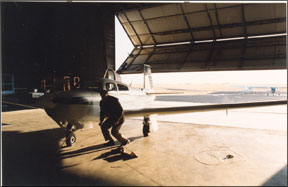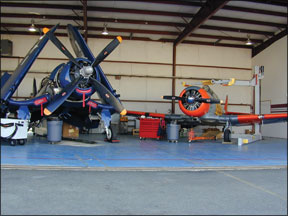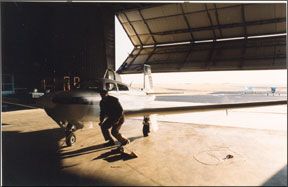Alongside what really happened to Amelia Earhart and whether shock cooling is mythical or not, the third great aviation mystery is this: If every airport has a hangar waiting list, why are there still so many airplanes roasting in tiedowns or buried under snow drifts? Clearly, given the choice, any aircraft owner wants a hangar-its just a better way to do business. But when the list grows short and its time put up or shut up, some owners balk at paying the $200 or $500 or whatever a month for sheltered storage. Its simple supply and demand versus not-so-simple cost versus value. This leads to these obvious questions: Whats the best way to pay for a hangar? Should you just rent one? Should you buy or build one and pay the airport for the leasehold? Or pay for a group hangar and risk hangar rash while someone else worries about maintaining the big metal box? Our research reveals there’s no one-size-fits-all answer for any of this. In general, on the coasts and in the big cities, you’ll pay a lot more for a hangar than you will in the sticks, if you can find one at all. Rural airports tend to be more hangar-rich environments. At some airports, you can build your own hangar or buy one, then lease the land long-term from the airport. Sometimes this makes sense, sometimes it doesnt. Well pencil out the numbers for you.
Renters Plight
When we were considering sharing a large hangar with another owner a few years ago, he told us his calculations favored remaining in a tiedown instead. In his calculus, by banking the difference between hangar and tiedown costs, he could easily afford fresh paint and interior work every four years or so. Just to put numbers on that, $3500 a year for four years would buy a mid-priced paint job and a new interior for a single. Thats about $290 a month, so by his math, the cost-value just wasnt appealing.
This is one way of measuring cost against value. But quantifying increased maintenance requirements from being in a tiedown instead of in a hangar-like finding $1 avgas-is all but impossible. In a tiedown, an airplane corrodes, avionics absorb moisture and heat and so on. Then there’s the hassle of removing snow and frost and digging a path to the taxiway.
But we can quantify how much it costs to rent, buy or build a hangar. Our research found the average rented hangar to be a T-shaped affair costing its tenant a minimum of $200 to $300 a month at rural airports, but far more at suburban or inner-city facilities. One example is in the Detroit suburbs at the Oakland County International Airport in Pontiac, Michigan. According to the airports Web site, it has a whopping 478 T-hangars, ranging from 42 feet wide to 48 feet. The smallest hangars rent for $260 or $300 a month, mid-size units are $299 or $340 and the largest are $380. Electricity is billed separately. The airport has waiting list procedures in place but, at present, hangars are available.
Moving closer to an urban center increases rates, but also quality and amenities. Reader Gregory Erikson told us, “Im based at DPA (DuPage County Airport, West Chicago, Illinois) I keep my Tiger in a 50-year-old-plus T-hangar and with the yearly cost increases now pay $454.50.” His hangar has an electric bifold door, which is recommended in snow country.
Ownership Economics
While renting a hangar is a good option, the renter has a problem: When the airplane is sold or its owner relocates, he or she has no equity representing the thousands of dollars shelled out in hangar rent. For some, thats a feature, not a bug. Even so, the renter is also at the mercy of the airport, FBO or hangar landlord on what can be done in or stored in the hangar and for improvements or repairs. Some airports are good landlords, some arent.
One solution is to own the hangar outright, whether by purchasing an existing structure or constructing a new one to suit your needs. But ownership is not for the faint of heart, or wallet, since hangars are commercial/industrial construction and subject to all of the codes and requirements of such structures.
In our view, many aircraft owners look at buying or building a hangar as just another aviation-related outlay, like an engine or paint or interior, when it really should be considered a real-estate transaction.
Here are the three basic concerns with hangar ownership. The first is the upfront purchase or construction cost, something far in excess of the first months rent of a comparable hangar. You can get a mortgage to finance the purchase or construction, but that takes effort and ties up financial resources and capital, since the hangar may not be a liquid asset.
If you needed to sell it, how long would it take? Whats the market at your airport for the kind of hangar you own or want to own? Just because you want a large structure with certain features to store your toys doesnt mean someone else will want the same building at the price you want them to pay when you get ready to sell.
Finally, our research revealed no deeded ownership of hangars on public airports. Unless you own the runway or live on a residential airpark, the airport will likely want its land back at some point, so they offer you leasehold arrangements. In other words, its your building on leased land.
Leaseholds vary widely in their terms. Airports that want to encourage construction with other peoples money may offer generous leaseholds that are cheap-say $50 a month-and long term, as much as 30 years in some cases. In a perfect world, youd have the opportunity to renegotiate another long-term lease on the land and stay in the same hangar without any additional outlays.
But there’s no guarantee of this. Local politics can rear its ugly head and the airport might decide to grant a long-term lease to someone else. It also could tear down the hangar and use it or the land under it for some other, more-lucrative purpose when the leasehold expires.
Leaseholds generally have clauses that revert ownership of the hangar back to the airport when the lease expires. Some owners negotiate leases that allow them the option of renting the hangar when this happens, but those that don’t can find themselves evicted, facing higher rents or even having to buy back the hangar they already own.
Lease Calendar
What matters most in a leasehold arrangement is where you are on the calendar. The closer the leasehold is to its termination, the less the value of the hangar. Buying a hangar with only a few years remaining on the leasehold is a viable option, but only if you know what happens when the lease expires.
One Florida owner wrote us about his leasehold. He bought a T-hangar for $15,000 with five years on the leasehold, at $105 a month. Not counting the lost opportunity of money-who considers that in aviation?-that works out to $355 a month, a bit more than the $325 going rate for rentals at his airport. When the lease expires, he walks away or makes a deal to rent the hangar from the airport. But when the lease goes, so does any resale value for the hangar.
But…if the airport renegotiates a long-term lease, the hangar instantly has resale value, so theoretically, the owner could get all of his purchase money back. If the hangar value has appreciated, he could even break even or make a slight profit.
Leaseholds with a term of 20 or 30 years are one answer. Entering into a fresh, 30-year lease on the land and buying an existing hangar for $50,000 will easily work to your advantage against a $400/month rental hangar over time. Shorter leaseholds-say 10 years-are less cost effective than renting, unless the local hangar economy is hot with appreciation.
Finding an airport on which to build your dream hangar can be a challenge. As always in real estate, location is key. For example, if you need a hangar in southeastern New Mexico, Vernon Wilson, airport manager at the Doa Ana County Airport (formerly 5T6, now DNA) says his facility, about 20 miles from the El Paso International Airport, may be ideal.
“We currently have no available hangars for rent. However, based on our recently completed master plan, we have about 300 acres of locations that can be leased for private hangar construction. Lease costs are currently about 20 cents per square foot per year. We will consider leases for construction of any size hangar or hangar complex.” A typical T-hangar is about 1100 square feet, so that works out to $220 a month for the leasehold.
Building New
So, how much does it cost to build a new hangar? Reader R. Scott deLuise: “I have been a real estate developer and pilot for 25 years, have built and sold many hangars, and currently own three hangars at two airports in Colorado. Until the end of 2007, availability was tight, and therefore demand for new hangars created a market for hangar condos on airport ground leases.
“This all changed as a result of a few things: The cost of steel and copper skyrocketed, fuel prices started to climb and the economy in general caught a cold. When the market was hot, new high quality hangars sold for as much as $75/square foot, bare bones. With the addition of insulation, heat and electrical upgrades, the price went upward of $90. Even with prices down to a more manageable $55 bare bones, some approved projects are not being built and there are some new hangars going begging. There’s no investment value with costs at these levels, because the rents necessary to create a reasonable ROI are not at market.” DeLuises numbers are for commercial hangar construction, those destined as rentals and for which return on investment is critical.
For another take, John Kelley of American Steel Buildings told us hes planning for materials-only cost of about $12.95 per square foot for a South Carolina project of seven T-hangars.
Thats only for the pre-fab steel components, but does include delivery. He figures $5.50 per square foot for foundation work and $2.50 to $3 for erection. This is the lowest cost we found. Kelley told us hes seeing a “weird year” and roughly a 25 percent increase in the cost of materials-raw steel-for his companys products. That said, its a steady market for new hangar construction, at least east of the Mississippi River where most of his activity is.
Mike Paris, chief engineer at FulFab, agrees the market is steady-perhaps ramping up a bit over the last 10 years. He concurs that steel prices are driving up costs. He reports a 20 percent price increase over last year, driven by demand for steel. Erect-A-Tubes sales manager, K.B. Shelton, concurs. Shelton says his company expects the cost of steel to double by the end of the summer, jacking up overall pre-fab hangar prices and he expects potential buyers will turn away because of the price. As one result, he cant give a firm quote on a hangar for delivery more than a few weeks in advance.
From Paris perspective, building a row of T-hangars will cost about twice the cost of materials. He says to expect about $15 per foot for the pre-fab steel, delivered, including bifold doors. Site prep and erection will at least double those costs. Optional features such as additional personnel doors, skylights, floor coatings and plumbing and electrical work will add to the cost, too. Shelton says his company estimates an average of $17 per foot, including the door, but not site work.
Significantly, Paris adds that his company is doing less manufacturing for individuals; its more for the airport itself. The result is a larger number of condo or rental hangars instead of corporate or personal facilities. “Were not seeing many hangars being built as an investment,” Paris says, as would be the case for a private company going into the hangar-rental business.
Location, Location
As avgas prices continue climbing and the overall U.S. economy remains weak, the hangar market also has entered an uncertain period. While Cirrus, Cessna and

others continue to sell high-end singles, their owners are keen on getting their new acquisitions out of the weather. Depending on where they base, finding a suitable hangar can be a challenge.
Clearly, renting is the easy solution to the perennial aircraft storage question, especially if youre not sure how long you’ll need hangarage. For owners certain of their long-term needs, building and/or owning can be attractive. Where those curves cross and when ownership becomes more cost-effective depends on the local rental market, how inexpensively the airport will lease the land and what it costs to build new, among other variables.
But its easy to run the math. Just total your monthly costs on five,10 and 20-year basis-renting versus owning. don’t assume any appreciation in value for an owned hangar, but do assume you’ll have to walk away at the end of the lease. The delta between the two bottom lines is as good a cost-value relationship as anything youre likely to see in aviation.


